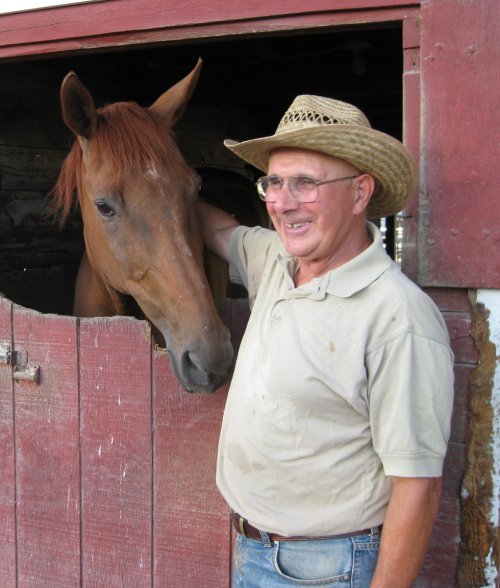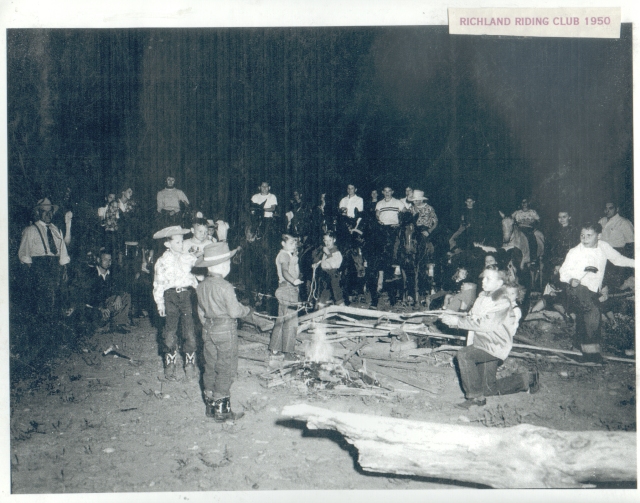The History of the RRC
(as told by its members, past and present)
This webpage is a work in progress. If you've got great memories of the RRC's history, or if you have old photographs of members, the property and/or events held at the RRC and would like to share them with us here on this page, please email them to webmaster(@ourdomain). We'll be happy to help you get your submissions edited, formatted and reviewed before we publish them here, and you can request your content to be supplemented, revised or even removed at any time.
 |
| Paul and Salute |
Paul Deichelbohrer writes:
The Richland Riders Club was originally part of a farm that included the desert to the north as far as Horn Rapids and the WE Johnson Park, all the way to Columbia Point. The farm’s barn is still standing — the big red barn across Van Giesen from the Club. The stone building next to it was the original farm house. These buildings are over a hundred years old. (I don't know the name of the farmers.)
A hundred years ago Richland was mostly orchards. Irrigation water came from the dam at Horn Rapids to supply a network of canals all over Richland. One of the canals became the drainage ditch that flows by Kadlec hospital. Another ran along the railroad tracks past the Richland Riders Club.
But, the farmer across the street raised cattle, not fruit. His summer pasture was the desert toward Horn Rapids. His winter pasture included the WE Johnson Park.
The AEC bought all of this land when it acquired Hanford. The orchards, etc were ripped out as needed for building, but a lot of the original businesses continued, e.g., The Spudnut Shop, Ganzels Barbershop, the farmer across Van Giesen, etc.
A number of Hanford workers and their kids hired on with the farmer to herd the cattle in their spare time. One of them was W.E. Johnson. He was the director of Hanford. Being from England, he liked to ride and pack. Of course he rode in an English saddle. He had Arabians. (Among his many accomplishments, he made sure that "jumping" was included in the Richland Riders Club Bylaws.)
WE Johnson was promoted to the head of the AEC after the war and he moved to Washington, DC. When he retired, he and his wife moved back to West Richland (Harrington Rd) where they lived the rest of their lives. The City of Richland named the WE Johnson Equestrian Park in his honor around 1985.
Back then the municipal dump was located at the end of Buckskin Loop. The WE Johnson Park had a lake in it across Hall Road from the Club. It was called Clear Lake. The City converted it into the landfill that we have today. Being a landfill, it cannot be developed. Also, the rest of the park floods every few years which prevents it from being developed, so we have a nice place to ride for the foreseeable future.
Before the Richland Rides Club, there were some early attempts to establish riding facilities. There was a 1-mile, straight away race track along Hall Rd (from Van Giesen to Chester Rd.) There were improvised rodeo facilities and boarding stables.
 |
| 1950's Club Campfire |
Around 1949 the riders in the area, which included rodeo riders, saddlebred riders, trail riders, and, of course, WE Johnson, organized the Richland Riders Club. The property was purchased from the AEC (I believe I remember for $2000). The Riders Club’s corporate charter was issued July 13, 1949 which is before the date of the incorporation of the City of Richland. The first facility at the Club was the low, pipe fence around the riding arena.
The Club hosted a major, national saddlebred horse show to inaugurate its founding. The major saddlebred aficionado was a doctor (I don't remember his name). He rode and organized the show. He also built what is now called the rental barns to put up the horses for the show. He designed them with a paddock separated from the stall by a door. In this way, two horses could be stabled in each barn—for example during a show. (I don't think this feature was ever used).
Legend has it that on a Monday morning, after a 3-day weekend, the Richland Riders Club members discovered that the rodeo arena had been built (including sound booth) inside of the low pipe fence. It seems that the rodeo rider faction of the membership got together over the long weekend and put it up.
There was some friction between the cowboys and the "high tail" riders. After a year or so, the Club bought the old farm house across Van Giesen to be a clubhouse. A big Christmas party was planned. It was indicated on the invitations that the members should dress up (e.g. ties). Of course, the cowboys came in their boots and jeans. The party ended in a brawl and the clubhouse was dropped. (I believe this is where we got our dress code for Board meetings). The current clubhouse was purchased from a WPPS excess sale around 1988.
Over the years some members have built other barns on the property until today when building new ones is no longer allowed. I know the order of a few of them: A1, A2, A3 were built by the doctor. A4, A5 and A6 were built by Ray Weaver who is sometimes known as the founder of the Richland Riders Club. Ray was an avid roper.
The rodeo facilities (break-out gates) were used for high school (junior) rodeos put on by the Richland Junior Riding Club (a subsidiary of the Richland Riders Club). Mostly, the cattle chutes were used for team roping practice. There used to be a release chute installed at the north end of the big arena and a lane running under the sound booth from holding pens at the south end of the main arena.
English riders began to invade in the early eighties. The old Columbia Hunter Jumper Club got started at what is now the East Side Equestrian Center in Kennewick. It put on a number of horse trials in the WE Johnson Park. The lower part of the park offers lots of opportunity to build natural cross country obstacles (water, banks, ditches, drops). Evidence of some of the jumps and temporary stabling are still visible in the park. The dressage phase and the stadium jumping phase were held at the Richland Riders Club or on the land fill.
In 1980 the Wednesday night Fun Shows were started to try to avoid some of the summer heat. The shows were successful and funded the trees around the perimeter of the grounds and the wash rack — both useful additions to combat the heat.
The natural elements have been kind to the Richland Riders Club. Of course, the sun is really bright and fades everything. All of the buildings used to be white, but were changed to the current barn red around 1983. We had a big wind at the end of 1990. I believe we had gusts over 100 mph. It blew the roof off of Barn B1 and deposited it in the corral of barn A5. The roof from Barns 1,2,3,4 ended up in C&M Nursery. The Club has been covered with flood water only in 1974 and 1996. The 1996 flood also covered the WE Johnson Park landfill. However, not in 1974. High water marks can still be seen on some of the barns. On three or four occasions we've had water back up from the south and flood Barns B1 through B3 plus A13 and A14.
From the days of the junior rodeo, there was a bleacher built in the gap in the trees along the west side. The bleacher actually was built before the road was paved and so was on the street right-of-way. Being "grandfathered", the bleacher had the right-of-way over the street. But, the wind in 1990 blew it over and left the gap in the trees.


